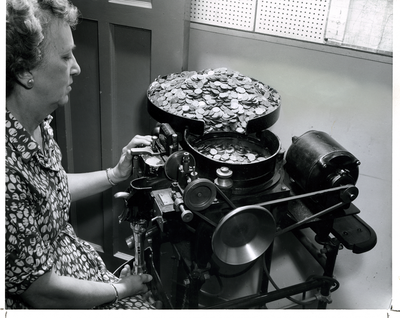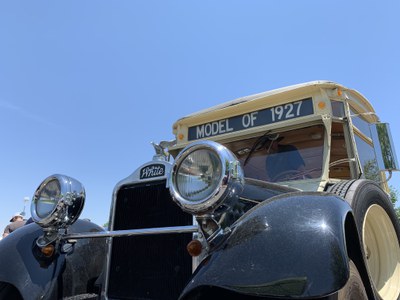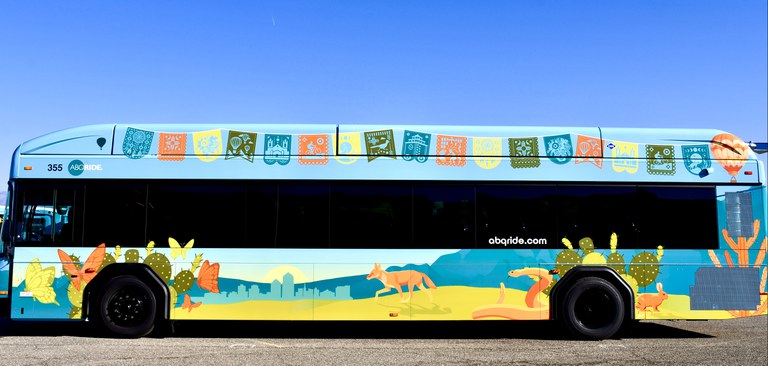Our Department
Department Core Values
- Dependable
- Respect
- Inclusive
- Value
- Excellence
City Goal Area
Public Infrastructure: Ensure that all-existing communities are adequately and efficiently served with well planned and coordinated, well maintained sewer, storm, water, and road systems and an integrated, multi-modal regional transportation system.
City Service Strategy
Provide effective, affordable, and diverse intermodal transportation alternatives to the single occupant vehicle.
Department Goals
- Provide visible and attractive alternatives to the use of the single occupant vehicle.
- Optimize the efficiency of all department operations to maximize efficient use of taxpayer dollars.
- Pursue an aggressive market development and education program to enhance public awareness of the availability and benefits of alternative transportation.
The History of Transit in Albuquerque
Milner Studio, Albuquerque Bus Company, ca. 1930, Albuquerque Museum
ABQ RIDE Yesterday, Today, and Tomorrow
ABQ Ride has a rich history, a vibrant life today, and a bright future.
The first vehicles used for public transportation on the streets of Albuquerque probably were horse-drawn wagons, used at least as early as the 1880s. By the early 20th century, there were horse-drawn streetcars on rails between Old Town and "New Town," as the railroad inspired shift of the center of Albuquerque commercial activity was known. This was the dawn of the grand era of the Alvarado Hotel on First Street. The adjacent Santa Fe Railway depot was a major interstate transportation stop. Local transportation was more basic. Of the early streetcars, it is said that if one's feet were tired, one could ride on them for a dime, but if one were in a hurry, better to walk.
In the years to follow, electrification appeared everywhere, and the primitive street railway was developed into a trolley system modern for its time. In 1917, it was reported Albuquerque encountered a labor shortage and women were employed as trolley operators. This was remarkable for the time, especially when you consider that 40 years later, some Eastern U.S. cities still would hire only men as transit coach drivers.
Midway through the 1920s, the trolley firm was going out of business. On January 1, 1928, a charter was granted to the new Albuquerque Bus Co. to serve transit needs in the greater Downtown area. The firm brought two 1927 White buses to Albuquerque to start its service. The buses' four-cylinder engines proved inadequate for the pull up East Central Avenue, and six-cylinder engines were installed. One of the original two buses has been acquired by ABQ RIDE, and renovated throughout by ABQ RIDE's own Maintenance Division. It is often shown in parades.
By 1933, there were no fewer than 11 buses in the fleet. A mural made from an early photograph of the bus lineup can be seen in the present ABQ RIDE Administration Building, 601 Yale Boulevard SE. It is interesting to note that the drivers as depicted wore livery, including woolen jodhpurs and jackets, even knee-high boots. The only interior climate control built into these early transit vehicles consisted of opening windows and flaps. The one-way fare was still a dime.
As the city grew, the service provided by the bus company grew, too. Keeping up with the city's growth in the post-World War II years proved increasingly difficult. By the early 1960s, urban transit buses had become highly efficient means of transporting people in mass numbers, but operating costs were climbing steadily. The place of the automobile in most people's daily lives, meanwhile, had become paramount. It had become nearly impossible for private operators to turn a profit in mass transit. Recognizing that the most efficient automobile could not serve every person's needs, the federal government offered substantial support and financial assistance to local governments willing to take the reins of mass transit. On January 1, 1965, Albuquerque became the first city to take advantage of the offer, and acquired the Albuquerque Bus Co. and the smaller Suburban Lines.
In the late 1970s, the fixed route bus service was complemented by an Elderly and Handicapped service for the mobility impaired. By the 1990s, the offering in Albuquerque of curb to curb service to persons unable to board and use regular buses eventually turned into the Sun Van program, which fulfilled a requirement by the Americans with Disabilities Act (ADA).
The continuing challenge for ABQ RIDE is to keep up with population growth, ever wider urban boundaries, and problems such as traffic congestion and air pollution that can be directly traced to the growth of automobiles as travel mode of choice for too many people. Here in the 21st century, however, public transit has become a more viable alternative for a growing number of commuters and people who cannot or would rather not rely on the automobile as their sole means of getting about town.
ABQ RIDE today in Albuquerque means cleaner, compressed natural gas fueled vehicles, expanded hours of service made possible by a dedicated gross receipts tax increment, customer information on bus travel, and other alternate modes of travel, such as ride-sharing, bicycling, and walking. The new Alvarado Transportation Center in Downtown Albuquerque is not only an intermodal transportation hub, but also occupies the same site as the grand old Alvarado Hotel and shares a very similar design.
In the years ahead, high capacity corridors will be defined and advanced transit systems, such as Bus Rapid Transit will be developed to serve the growing needs of the people of Albuquerque and visitors to our city. The history of transit has been colorful; its future is bright.




